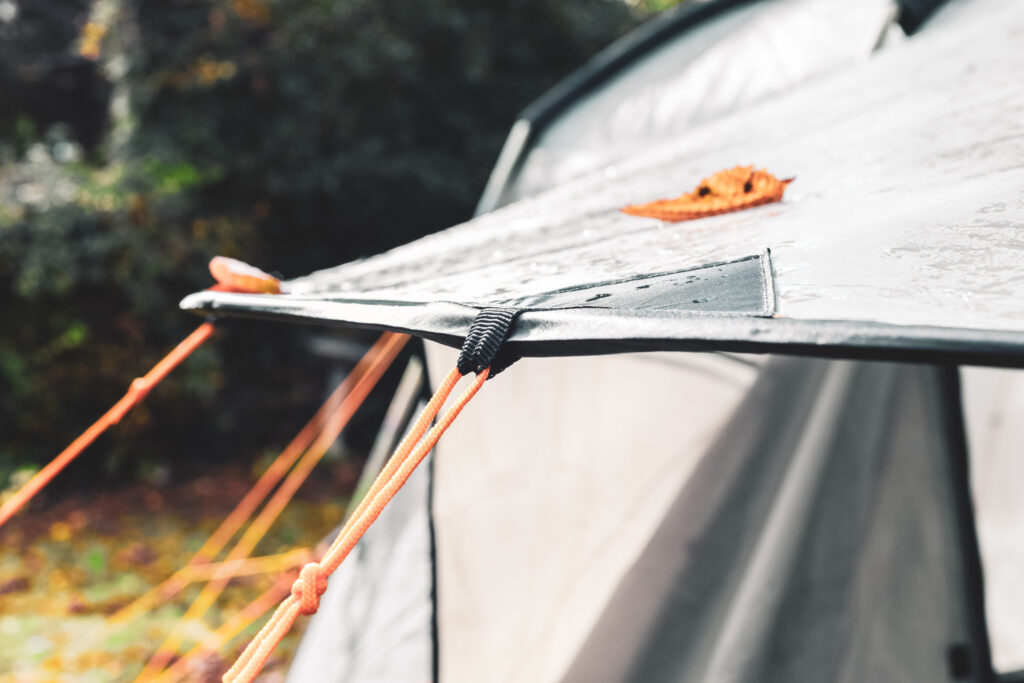Navigating the Waters: A Comprehensive Guide to Tent Hydrostatic Head
Embarking on a camping adventure brings the necessity of ensuring a dry and comfortable shelter, pivotal in enhancing your outdoor experience. The term ‘Hydrostatic Head’ (HH) often surfaces when exploring waterproofing capabilities of tents. But what does it signify, and how does it impact your camping gear selection? Let’s delve into understanding and navigating through the intricacies of HH.
My name is Andy and Ive been camping for the past 30 years and worked in the outdoor and retail industry for over 10 years so have quite a lot of camping experience. I’ve camped in all weather’s and all year round.

Unveiling Hydrostatic Head: A Measurement of Water Resistance
Hydrostatic Head, in essence, quantifies the water resistance of a material, measured by the height (in mm) of a water column that the fabric can sustain before succumbing to leakage. For instance, a tent fabric with an HH of 3000mm can withstand a water column of 3000mm before water begins to permeate through. Thus, a higher HH denotes superior water resistance, but is it the sole factor to consider for a waterproof tent?
Deciphering Adequate Hydrostatic Head for Tents
While a higher HH implies enhanced water resistance, it’s pivotal to discern the optimal HH for your tent, contingent on your camping environment. A tent with an HH of 3000mm is generally deemed sufficient to endure UK rainfall. However, for environments with harsher rain or snow, an HH ranging from 5000mm to 10000mm is advisable. Conversely, for drier regions, an HH above 1000mm might suffice.
Beyond Numbers: Other Facets of Tent Waterproofing
Although HH provides a foundational understanding of a material’s water resistance, it’s not the solitary determinant of a tent’s waterproofing efficacy. Factors such as the tent’s overall design, seam sealing, and zipper quality also play pivotal roles. A tent with a lower HH but well-sealed seams and zipper covers might outperform a tent with a higher HH but compromised design elements.
Groundsheets: The Unsung Heroes of Waterproofing
Groundsheets, often overshadowed, are integral in ensuring a dry interior, typically boasting a higher HH than the tent fabric due to their constant interaction with ground moisture. However, their thickness and durability against wear and tear are also paramount to prevent water ingress from the ground, ensuring a dry and comfortable camping experience.
Enhancing Your Tent’s Water Resistance
While the inherent HH of a tent can’t be altered, augmenting its water resistance is plausible. Employing seam sealers to create a watertight seal, utilizing tarps for an additional protective layer, and applying waterproof coatings are viable methods to bolster your tent’s defence against the elements, ensuring a dry interior amidst the pouring rain.
UK Hydrostatic Head (HH) Recommendations for Various Weather Conditions
When it comes to choosing the right tent for your outdoor adventures in the United Kingdom, understanding Hydrostatic Head (HH) ratings is crucial. HH measures a tent’s waterproofness, and different weather conditions demand different HH ratings for optimal comfort and protection. Here are the UK HH recommendations for various weather conditions:
1. General UK Weather:
- For typical UK weather, which often includes light to moderate rain and occasional showers, a tent with an HH rating of around 1500mm to 3000mm is usually sufficient.
- Tents in this range should keep you dry during standard camping conditions.
2. Heavy Rain and Strong Winds:
- When camping in conditions with heavy rain and strong winds, consider tents with higher HH ratings, typically ranging from 2000mm to 3000mm.
- These tents are designed to withstand the added pressure of wind-driven rain.
3. Extended Rainfall:
- In situations where you expect continuous and prolonged rainfall, such as in the UK’s more drizzly regions, it’s advisable to opt for tents with HH ratings of 3000mm or higher.
- This extra waterproofing ensures that your tent remains a comfortable and dry shelter during extended downpours.
4. Winter and Snow Camping:
- For winter camping, especially in conditions involving snow and wetness, look for tents with high HH ratings.
- Tents designed for winter camping should ideally have HH ratings exceeding 3000mm to 5000mm to provide a reliable barrier against snow and moisture.
5. Extreme UK Weather:
- During severe storms, torrential downpours, or other extreme weather conditions, it’s crucial to have tents with the highest HH ratings available.
- These tents typically have HH ratings well above 5000mm to offer maximum protection and peace of mind.
Remember that the choice of the right HH rating should align with your specific camping needs, the time of year, and the expected weather conditions. Always check the manufacturer’s specifications and consider the unique climate of your camping location when selecting a tent. With the right HH-rated tent, you can enjoy your outdoor adventures in the UK while staying comfortably dry regardless of the weather.
Exploring the Science Behind Hydrostatic Head (HH) Ratings
Hydrostatic Head (HH) ratings may seem like a technical term associated with outdoor gear, but understanding the science behind it is essential for outdoor enthusiasts. Essentially, HH measures a material’s ability to resist the penetration of water, and it plays a significant role in keeping you dry during outdoor adventures. Let’s delve deeper into the science of HH in a way that’s accessible and insightful.
Understanding HH in Layman’s Terms: Imagine HH as the ‘water pressure threshold’ that a material can endure before it allows water to seep through. When rain or water droplets land on a fabric, they exert a force due to gravity. This force is what we call ‘hydrostatic pressure.’ The HH rating indicates how much hydrostatic pressure the material can withstand before it yields to water penetration.
The Measuring Process: To determine HH, a sample of the material is carefully placed under a cylindrical tube filled with water. As more water fills the tube, it creates pressure on the material. Technicians gradually increase the water level until the material lets water through. The height of the water column at that point is recorded as the HH rating, usually in millimetres (mm).
The Science of Waterproof Membranes: Modern outdoor gear often features waterproof membranes like Gore-Tex. These membranes consist of microscopic pores that are too small for water droplets to pass through but large enough to allow water vapour (sweat) to escape. This breathability is a critical aspect of waterproofing, as it keeps you dry from both outside and inside moisture.
Quality Control and Testing: Manufacturers meticulously test their materials to determine accurate HH ratings. Rigorous quality control ensures that outdoor gear performs as specified, keeping you comfortable in diverse weather conditions.
My tent is a Outwell Sundale 7 person tent which has a HH of 6,000. But even that wasn’t good enough during a camping trip this summer. We had a months rain in about 3 hours and would have needed to stay in a caravan to keep the water out. The issue was there was no wind to help dry the tent. However over the next couple of days it did dry out and when the rain returned it was great at keeping the rain out.
What HH do I need for camping?
The first thing to consider is when you are planning on camping, if its just summer camping then a lower HH is needed, if you are planning on camping in the middle of winter in the Highlands of Scotland then a higher HH over 5000 is recommend.
Recommend HH for camping in each country
A comprehensive table with recommended Hydrostatic Head (HH) ratings for camping in each country worldwide. HH ratings often depend on various factors, including the time of year and the type of camping (e.g., winter camping, summer camping). Instead, I have provide some general guidelines that can be useful for campers in different parts of the world:
| Country / Region | Recommended HH Rating for Camping |
|---|---|
| United Kingdom (UK) | 1500mm to 3000mm |
| United States (US) | 1000mm to 3000mm |
| Canada | 1500mm to 3000mm |
| Australia | 1000mm to 3000mm |
| Nordic Countries | 3000mm to 5000mm or higher |
| Alpine Regions | 3000mm to 5000mm or higher |
| Desert Regions | 1000mm to 2000mm |
These recommendations serve as general guidelines and can vary depending on specific camping conditions within each country or region. Always consider the time of year, expected weather conditions, and the type of camping you plan to do when selecting camping gear with appropriate HH ratings. Additionally, consult with local experts or campers for region-specific advice to ensure a comfortable and dry camping experience
Navigating through the concept of Hydrostatic Head and understanding its implications on tent waterproofing are pivotal in making informed decisions for your camping adventures. While HH provides a fundamental gauge of water resistance, considering additional factors such as tent design and employing supplementary waterproofing methods are equally crucial. As you embark on your next outdoor escapade, may your shelter remain steadfastly dry, enhancing your communion with nature.
Andy Halliday is a passionate outdoor enthusiast and an avid camper. He has been exploring the wilderness and camping in the great outdoors for over two decades, and his experiences have inspired him to write about the joys of camping and the beauty of nature.
As a camping enthusiast, he believes that spending time in the wilderness is not just a way to escape the daily grind, but also a way to connect with nature and gain a deeper appreciation for the natural world. Andy has camped in various locations across the country and on two different continents. He has a wealth of knowledge and experience to share with fellow campers.
Through his writing, he hopes to inspire you to venture out into the wilderness and experience the beauty and serenity of camping. Andy articles and guides provide useful tips, advice, and insights on everything from selecting the right gear and equipment to finding the best campsites and hiking trails.





